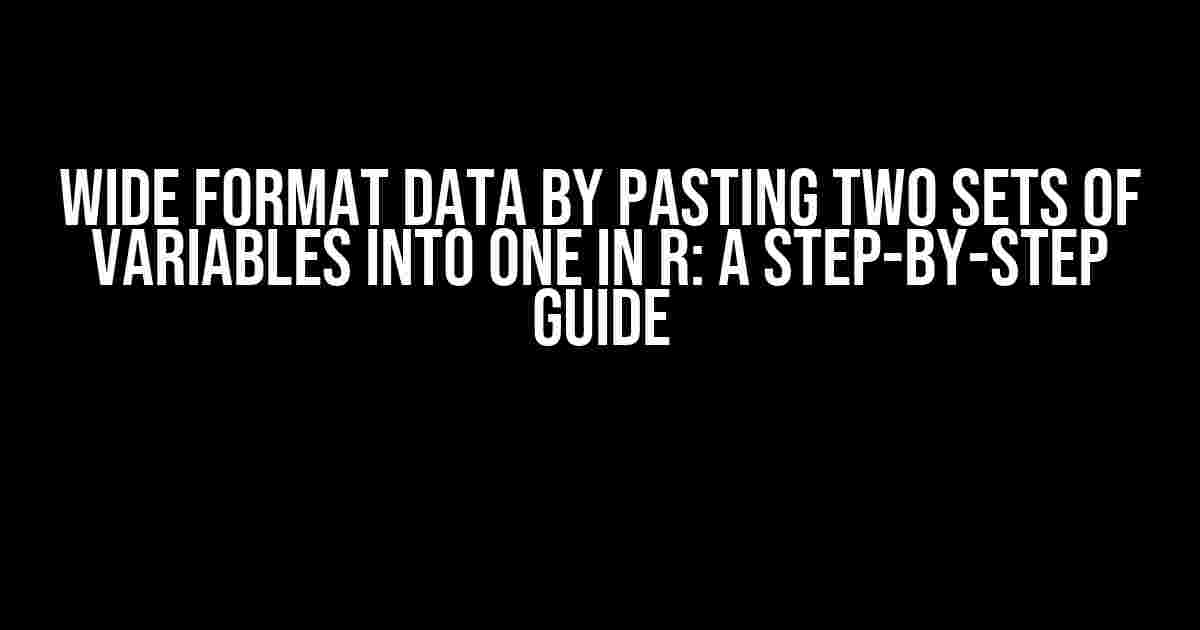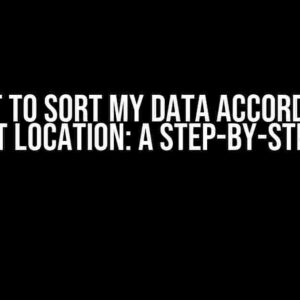Are you tired of dealing with narrow format data that makes it difficult to visualize and analyze your data? Do you want to know the secret to transforming your data into a wide format that’s easy to work with? Look no further! In this article, we’ll show you how to paste two sets of variables into one in R, creating a wide format data that’s perfect for data analysis and visualization.
What is Wide Format Data?
Before we dive into the process of creating wide format data, let’s take a step back and understand what wide format data is. Wide format data is a type of data structure where each row represents a single observation, and each column represents a variable. This format is ideal for data analysis and visualization because it allows you to easily compare and contrast different variables.
In contrast, narrow format data has multiple rows for each observation, with each row representing a single variable. This format can be cumbersome to work with and makes it difficult to visualize and analyze the data.
Why is Wide Format Data Important?
Wide format data is essential for data analysis and visualization because it provides a clear and concise view of the data. With wide format data, you can:
- Easy visualize and compare different variables
- Perform statistical analysis and modeling
- Create accurate and informative data visualizations
- Identify patterns and trends in the data
How to Paste Two Sets of Variables into One in R
Now that we’ve covered the importance of wide format data, let’s dive into the process of creating it in R. The process involves pasting two sets of variables into one using the `cbind()` function.
# Load the datasets
dataset1 <- data.frame(X1 = c(1, 2, 3), Y1 = c(4, 5, 6))
dataset2 <- data.frame(X2 = c(7, 8, 9), Y2 = c(10, 11, 12))
# View the datasets
dataset1
dataset2
# Paste the datasets together using cbind()
wide_data <- cbind(dataset1, dataset2)
# View the wide format data
wide_data
In this example, we have two datasets, `dataset1` and `dataset2`, each with two variables, `X1` and `Y1`, and `X2` and `Y2`, respectively. We use the `cbind()` function to paste the two datasets together, creating a wide format data with four variables, `X1`, `Y1`, `X2`, and `Y2`.
Real-World Example: Pasting Two Sets of Variables into One
Let's consider a real-world example where we have two datasets, `sales_data` and `customer_data`, each with several variables.
# Load the datasets
sales_data <- data.frame(
customer_id = c(1, 2, 3, 4, 5),
sales_amount = c(100, 200, 300, 400, 500)
)
customer_data <- data.frame(
customer_id = c(1, 2, 3, 4, 5),
customer_name = c("John", "Jane", "Bob", "Alice", "Mike"),
customer_age = c(25, 30, 35, 40, 45)
)
# View the datasets
sales_data
customer_data
# Paste the datasets together using cbind()
wide_data <- cbind(sales_data, customer_data)
# View the wide format data
wide_data
In this example, we have two datasets, `sales_data` and `customer_data`, each with several variables. We use the `cbind()` function to paste the two datasets together, creating a wide format data with five variables, `customer_id`, `sales_amount`, `customer_name`, `customer_age`, and `customer_id`.
Tips and Tricks
Here are some tips and tricks to keep in mind when pasting two sets of variables into one in R:
- Make sure the datasets have the same number of rows
- Use the `cbind()` function to paste the datasets together
- Use the `merge()` function to merge the datasets based on a common variable
- Use the `reshape()` function to reshape the data from narrow to wide format
Common Errors and Solutions
When pasting two sets of variables into one in R, you may encounter some common errors. Here are some solutions to common errors:
| Error | Solution |
|---|---|
| Error: cannot combine columns of different lengths | Make sure the datasets have the same number of rows |
| Error: cannot combine columns of different classes | Use the `as.matrix()` function to convert the datasets to matrices |
| Error: cannot combine columns with different names | Rename the columns to have the same names |
Conclusion
In conclusion, pasting two sets of variables into one in R is a simple and efficient way to create wide format data that's perfect for data analysis and visualization. By following the steps outlined in this article, you can easily create wide format data and unlock the full potential of your data.
Remember to keep the tips and tricks in mind, and solutions to common errors to ensure a smooth and error-free process. With wide format data, you can:
- Easily visualize and compare different variables
- Perform statistical analysis and modeling
- Create accurate and informative data visualizations
- Identify patterns and trends in the data
So, what are you waiting for? Start creating wide format data today and take your data analysis to the next level!
Frequently Asked Question
Stuck with merging two sets of variables into one in R? Don't worry, we've got you covered! Here are some frequently asked questions to help you navigate wide format data.
Q1: What is the purpose of converting data to wide format in R?
Converting data to wide format in R allows for easier data manipulation and analysis, especially when working with multiple variables. It enables the creation of new variables, performing calculations, and visualizing data more efficiently.
Q2: How do I convert long format data to wide format data in R?
You can use the `pivot_wider()` function from the `tidyr` package to convert long format data to wide format data in R. This function takes the names of the key and value columns as arguments, and returns a wide format data frame.
Q3: Can I merge two sets of variables into one using the `cbind()` function in R?
Yes, you can use the `cbind()` function to merge two sets of variables into one in R. However, this function is limited to combining data frames with the same number of rows. For more flexibility, consider using the `merge()` function or `left_join()` from the `dplyr` package.
Q4: How do I handle missing values when converting data to wide format in R?
When converting data to wide format in R, missing values can be handled using the `values_fill` argument in the `pivot_wider()` function. This argument allows you to specify a value to replace missing values with, such as NA or a specific value.
Q5: Can I use the `reshape()` function to convert data to wide format in R?
Yes, the `reshape()` function can be used to convert data to wide format in R, but it has been deprecated in favor of the `pivot_wider()` function from the `tidyr` package. `pivot_wider()` is more flexible and easier to use, making it the recommended approach for converting data to wide format.




